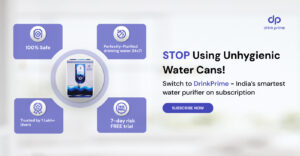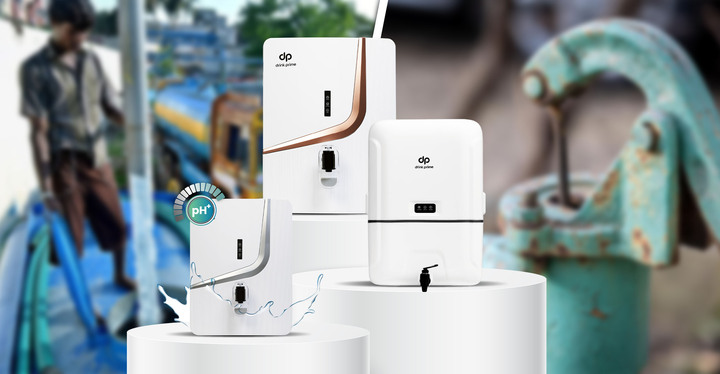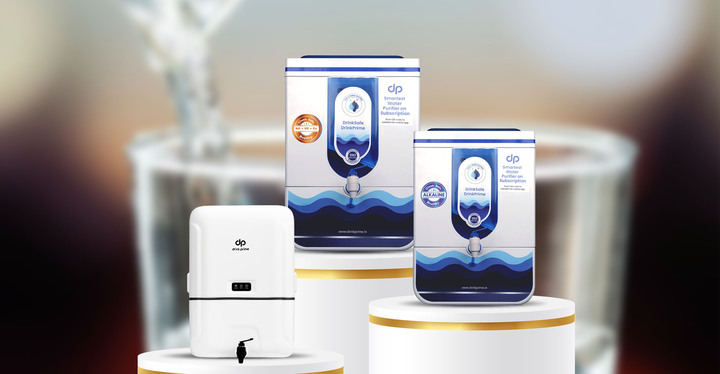Water pollution is an unfortunate reality of our current times and it’s a threat that is global. Whether it is water that you consume daily or used for industrial applications, water analysis is important to determine its quality. So, if your water causes unsightly stains, waterborne infections, or simply tastes and smells bad, a complete examination will help identify the root cause and help decide on a water treatment plan. Many water testing parameters are used to analyze the quality of water. In this blog, we investigate these parameters and how they help you get safe water.
What parameters do you need to test for drinking water?
The water that you consume must meet certain standards of water quality parameters. The Central Pollution Control Board, which is the agency that monitors the water quality in India, has set guidelines that ensure that the water that you consume is safe from contaminants.
Broadly, three water quality testing parameters are used to test the quality of water THAT are physical, chemical, and biological parameters. Together, they ensure contaminant-free water for consumption.
These parameters are important because they can be used to find out the quality of water, which is used for a wide variety of applications. For instance, one of the indicators of water quality is dissolved oxygen, which is crucial to finding out river water quality. Lower dissolved oxygen indicates higher pollution levels and that the contaminants are absorbing the dissolved oxygen.
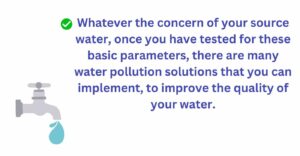
Physical parameters for testing water quality
Physical parameters are usually detected as they cause physical changes to the water. Some of the important physical drinking water testing parameters are:
1. Electrical conductivity
The capacity of water to conduct electric current over a distance in water, is known as electrical conductivity. It is measured in Siemens per distance. The accumulation of ions is what gives water this capacity and it originates from inorganic matter, dissolved solids, etc.
EC is an excellent parameter to assess water quality. Water with a high EC usually has a larger amount of contaminants, while pure water will not be able to effectively conduct electric currents, as the contaminant levels will be negligible. A conductivity meter is generally used to measure electrical conductivity.
2. Taste and odor
This is one of the most visible signs of water contamination as a change in taste and odor is usually indicative of the presence of contaminants in the water. This may include organic matter, inorganic compounds, dissolved gasses etc.
3. Total dissolved solids
These contaminants can mix with water from various sources like sewage, agricultural runoff or water treatment chemicals. The higher the TDS, the higher will be the conductivity. By measuring the TDS, you can know how much organic matter is present in the water. Usually, water with a TDS of greater than 500 ppm is regarded as bad. A TDS meter will give you the TDS levels but will not give information on what types of TDS are found. So, a home water test kit or a lab analysis is your best bet.
4. Turbidity
The presence of suspended solids and particles gives water that haziness known as turbidity. When the levels of total suspended solids and TDS in the water increase, turbidity also rises. Turbidity analyzers are very important in a lot of industries. E.g. It is used to check the cloudiness of beverages like wine, beer, etc., and to check the quality of aquatic systems, drinking water supplies, etc. Turbidity, while it makes water appear cloudy, is also an important indicator of the presence of pathogens and other contaminants in water.
5. Temperature
Temperature measured in Fahrenheit or Celsius, is indicative of the kinetic energy of the molecules in the water. It influences other drinking water testing parameters like pH level. When temperature increases pH levels dip. The dissolved oxygen levels in water decrease as temperature increases as they have an inverse relationship.
Chemical parameters of water quality
These parameters assess the chemical attributes of water. They are:
1. pH
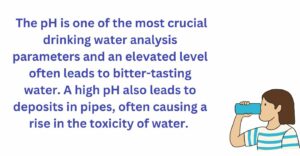
This is one of the most crucial drinking water analysis parameters and an elevated level often leads to bitter-tasting water. A high pH also leads to deposits in pipes, often causing a rise in the toxicity of water. A pH sensor or probe is a good bet to test the pH of water. pH tells us how much hydrogen is present in water and usually ranges from 0 to 14, with readings below 7 being acidic, above 7 being alkaline, and 7, neutral. Drinking water usually has a pH of about 6.5 to 8.5.
2. Acidity
This tells us the acid levels in the water and is usually caused by inorganic acids, carbon dioxide, etc., and is measured by a pH probe or sensor. Acidic water is known to increase the corrosion from chemical reactions and may affect biological activities in water.
Alkalinity: This parameter tells us how well water can neutralize the acids and is important as it helps to decide how much soda ash is to be added to neutralize water. A high alkaline level shows the presence of contaminants.
3. Hardness
This indicates the presence of minerals like calcium or magnesium. Groundwater is harder, and it can cause scaling and difficulty in bathing. Hardness strip meters or colorimeters are used to detect this.
4. Dissolved oxygen
This refers to the amount of oxygen in the water and it gets into water because of photosynthesis, atmospheric absorption, groundwater discharge etc. This is an important parameter because if the oxygen levels drop then aquatic organisms cannot survive. This is especially useful in water treatment plants. If DO levels are high, then the quality of water will be good as DO occurs, due to the solubility of oxygen. A colorimeter or electrometric method is used to measure this.
5. Biological paraments
They usually look at the presence or absence of pathogens and other microbes in water. Some common ones are bacteria, algae, viruses, etc.
Get 7 Days Risk Free Trial
Conclusion
While attempting to treat any kind of water you must have an idea of these basic parameters, to arrive at the ideal treatment plan. Whatever the concern of your source water, once you have tested for these basic parameters, there are many water pollution solutions that you can implement, to improve the quality of your water.

